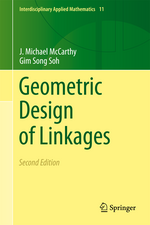Applications of Functional Analysis in Engineering: Mathematical Concepts and Methods in Science and Engineering, cartea 22
Autor J. Nowinskien Limba Engleză Paperback – 24 dec 2012
Din seria Mathematical Concepts and Methods in Science and Engineering
-
 Preț: 394.30 lei
Preț: 394.30 lei - 18%
 Preț: 718.19 lei
Preț: 718.19 lei -
 Preț: 387.52 lei
Preț: 387.52 lei -
 Preț: 378.63 lei
Preț: 378.63 lei -
 Preț: 389.61 lei
Preț: 389.61 lei -
 Preț: 392.05 lei
Preț: 392.05 lei -
 Preț: 376.60 lei
Preț: 376.60 lei -
 Preț: 376.76 lei
Preț: 376.76 lei -
 Preț: 382.24 lei
Preț: 382.24 lei -
 Preț: 375.06 lei
Preț: 375.06 lei -
 Preț: 378.63 lei
Preț: 378.63 lei - 20%
 Preț: 629.52 lei
Preț: 629.52 lei -
 Preț: 390.14 lei
Preț: 390.14 lei -
 Preț: 380.17 lei
Preț: 380.17 lei - 15%
 Preț: 640.57 lei
Preț: 640.57 lei - 20%
 Preț: 327.02 lei
Preț: 327.02 lei - 15%
 Preț: 626.33 lei
Preț: 626.33 lei - 20%
 Preț: 330.09 lei
Preț: 330.09 lei -
 Preț: 375.06 lei
Preț: 375.06 lei - 15%
 Preț: 639.80 lei
Preț: 639.80 lei - 15%
 Preț: 592.47 lei
Preț: 592.47 lei -
 Preț: 383.16 lei
Preț: 383.16 lei - 18%
 Preț: 927.55 lei
Preț: 927.55 lei - 18%
 Preț: 937.29 lei
Preț: 937.29 lei -
 Preț: 381.09 lei
Preț: 381.09 lei - 18%
 Preț: 936.81 lei
Preț: 936.81 lei - 15%
 Preț: 631.61 lei
Preț: 631.61 lei - 18%
 Preț: 937.91 lei
Preț: 937.91 lei - 18%
 Preț: 1208.35 lei
Preț: 1208.35 lei - 18%
 Preț: 1208.49 lei
Preț: 1208.49 lei -
 Preț: 384.49 lei
Preț: 384.49 lei - 18%
 Preț: 938.51 lei
Preț: 938.51 lei - 15%
 Preț: 625.98 lei
Preț: 625.98 lei - 18%
 Preț: 930.78 lei
Preț: 930.78 lei - 15%
 Preț: 635.63 lei
Preț: 635.63 lei
Preț: 381.09 lei
Nou
Puncte Express: 572
Preț estimativ în valută:
72.93€ • 75.76$ • 60.58£
72.93€ • 75.76$ • 60.58£
Carte tipărită la comandă
Livrare economică 03-17 februarie 25
Preluare comenzi: 021 569.72.76
Specificații
ISBN-13: 9781468439281
ISBN-10: 1468439286
Pagini: 324
Ilustrații: XV, 304 p.
Greutate: 0.44 kg
Ediția:Softcover reprint of the original 1st ed. 1981
Editura: Springer Us
Colecția Springer
Seria Mathematical Concepts and Methods in Science and Engineering
Locul publicării:New York, NY, United States
ISBN-10: 1468439286
Pagini: 324
Ilustrații: XV, 304 p.
Greutate: 0.44 kg
Ediția:Softcover reprint of the original 1st ed. 1981
Editura: Springer Us
Colecția Springer
Seria Mathematical Concepts and Methods in Science and Engineering
Locul publicării:New York, NY, United States
Public țintă
ResearchCuprins
1. Physical Space. Abstract Spaces.- Comment 1.1.- 2. Basic Vector Algebra.- Axioms 2.1–2.3 and Definitions 2.1–2.3.- Axioms 2.4–2.8.- Theorem 2.1 (Parallelogram Law).- Problems.- 3. Inner Product of Vectors. Norm.- Definitions 3.1 and 3.2.- Pythagorean Theorem.- Minkowski Inequality.- Cauchy—Schwarz Inequality.- Problems.- 4. Linear Independence. Vector Components. Space Dimension.- Span. Basis. Space Dimension.- Vector Components.- Problems.- 5. Euclidean Spaces of Many Dimensions.- Definitions 5.1–5.6.- Definitions 5.7–5.9.- Orthogonal Projections.- Cauchy—Schwarz and Minkowski Inequalities.- Gram—Schmidt Orthogonalization Process.- lp–Space.- Problems.- 6. Infinite-Dimensional Euclidean Spaces.- Section 6.1. Convergence of a Sequence of Vectors in ??.- Cauchy Sequence.- Section 6.2. Linear Independence. Span, Basis.- Section 6.3. Linear Manifold.- Subspace.- Distance.- Cauchy—Schwarz Inequality.- Remark 6.1.- Problems.- 7. Abstract Spaces. Hilbert Space.- Linear Vector Space. Axioms.- Inner Product.- Pre-Hilbert Space. Dimension. Completeness. Separability.- Metric Space.- Space Ca?t?b and l1.- Normed Spaces. Banach Spaces.- Fourier Coefficients.- Bessel’s Inequality. Parseval’s Equality.- Section 7.1. Contraction Mapping.- Problems.- 8. Function Space.- Hilbert, Dirichlet, and Minkowski Products.- Positive Semi-Definite Metric.- Semi-Norm.- Clapeyron Theorem.- Rayleigh—Betti Theorem.- Linear Differential Operators. Functionals.- Variational Principles.- Bending of Isotropic Plates.- Torsion of Isotropic Bars.- Section 8.1. Theory of Quantum Mechanics.- Problems.- 9. Some Geometry of Function Space.- Translated Subspaces.- Intrinsic and Extrinsic Vectors.- Hyperplanes.- Convexity.- Perpendicularity. Distance.- OrthogonalProjections.- Orthogonal Complement. Direct Sum.- n-Spheres and Hyperspheres.- Balls.- Problems.- 10. Closeness of Functions. Approximation in the Mean. Fourier Expansions.- Uniform Convergence. Mean Square.- Energy Norm.- Space ?2.- Generalized Fourier Series.- Eigenvalue Problems.- Problems.- 11. Bounds and Inequalities.- Lower and Upper Bounds.- Neumann Problem. Dirichlet Integral.- Dirichlet Problem.- Hypercircle.- Geometrical Illustrations.- Bounds and Approximation in the Mean.- Example 11.1. Torsion of an Anisotropic Bar (Numerical Example).- Example 11.2. Bounds for Deflection of Anisotropic Plates (Numerical Example).- Section 11.1. Bounds for a Solution at a Point.- Section 11.1.1. The L*L Method of Kato—Fujita.- Poisson’s Problem.- Section 11.1.2. The Diaz-Greenberg Method.- Example 11.3. Bending a Circular Plate (Numerical Example).- Section 11.1.3. The Washizu Procedure.- Example 11.4. Circular Plate (Numerical Example).- Problems.- 12. The Method of the Hypercircle.- Elastic State Vector.- Inner Product.- Orthogonal Subspaces.- Uniqueness Theorem.- Vertices.- Hypersphere. Hyperplane. Hypercircle.- Section 12.1. Bounds on an Elastic State.- Fundamental and Auxiliary States.- Example 12.1. Elastic Cylinder in Gravity Field (Numerical Example).- Galerkin Method.- Section 12.2. Bounds for a Solution at a Point.- Green’s Function.- Section 12.3. Hypercircle Method and Function Space Inequalities.- Section 12.4. A Comment.- Problems.- 13. The Method of Orthogonal Projections.- Illustrations. Projection Theorem.- Example 13.1. Arithmetic Progression (Numerical Example).- Example 13.2. A Heated Bar (Numerical Example).- Section 13.1. Theory of Approximations. Chebyshev Norm.- Example 13.3. Linear Approximation (Numerical Example).- Problems.- 14. TheRayleigh—Ritz and Trefftz Methods.- Section 14.1. The Rayleigh—Ritz Method.- Coordinate Functions. Admissibility.- Sequences of Functionals.- Lagrange and Castigliano Principles.- Example 14.1. Bounds for Torsional Rigidity.- Example 14.2. Biharmonic Problem.- Section 14.2. The Trefftz Method.- Dirichlet Problem. More General Problem.- Section 14.3. Remark.- Section 14.4. Improvement of Bounds.- Problems.- 15. Function Space and Variational Methods.- Section 15.1. The Inverse Method.- Symmetry and Nondegeneracy of Forms.- Section 15.2. Orthogonal Subspaces.- Minimum Principles.- Section 15.3. Laws’ Approach.- Reciprocal and Clapeyron Theorems.- Minimum Energy Theorem.- Section 15.4. A Plane Tripod.- Lines of Self-Equilibrated Stress and Equilibrium States.- Minimum Principle.- Maximum Principle.- Problems.- 16. Distributions. Sobolev Spaces.- Section 16.1. Distributions.- Delta Function.- Test Functions.- Functionals.- Distribution.- Differentiation of Distributions.- An Example.- Section 16.2. Sobolev Spaces.- Answers to Problems.- References.

















